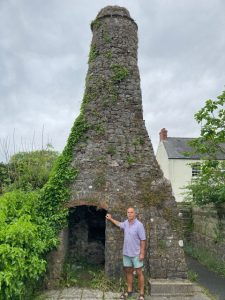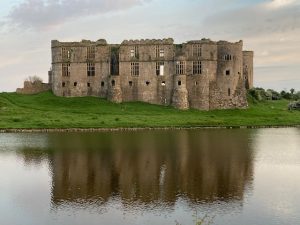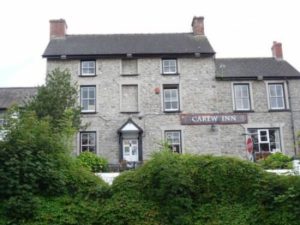
Well here it is, what is possibly the oldest Chimney in Wales, in the village of Carew close to Tenby. We have just had a short week away, travelling around the country visiting family as well as sightseeing, when we came across this chimney. It is called a Flemish chimney as the people who originally constructed it were Flemish immigrants who arrived in this part of Wales in the 13th and 14th centuries. The chimney is believed to have been built sometime in the 14th century and originally would have had a house adjoining it, which is clearly no longer there. The chimney is roughly circular in construction and has a bread oven at its base. Having said all this, other commentators believe that the association with the Flemmings is totally erroneous and that it was actually only constructed as late as the 19th century. Appparently the adjoining house was demolished in 1927 after being used as a communal bake house. During World War II two local families used it as a shelter from German air-raids. As far as we know, the oldest chimneys in Wales can be found in some of the country’s medieval castles.
During our time in Carew, we stayed at the Carew Inn, which we would highly recommend, and we visited Carew Castle which is literally just over the road from the Inn. At the end of the 11th century, the Normans extended their conquest of England into Wales and Pembroke Castle became the centre of Norman rule in South Pembrokeshire.
Gerald de Windsor was constable of the Castle on behalf of Henry I when he decided to build his own fortification on the Carew River, some ten miles up the tidal waterway from Pembroke. This was not the first settlement on the site, however. Excavation has revealed an Iron Age settlement. A substantial five-ditched promontory fort has been unearthed, together with large quantities of Roman pottery. A Dark Age settlement or fort may also have existed on the site. Gerald’s fortification was probably built of earth and wooden stakes. This fortification was later replaced by a stone Castle. Much of what remains of Carew Castle today was the work of Sir Nicholas de Carew (who died in 1311), who was responsible in particular for the east and west ranges.

In the late fifteenth century the Castle was greatly improved and extended by a very colourful character, Sir Rhys ap Thomas (1449-1525). He altered both the east and west ranges, and was responsible for many of the Bath stone windows and other features. Gaining the implicit trust of both Henry VII and Henry VIII, he was said ‘to rule this corner of Wales like a King’. The final development took Carew from Medieval fortress to Elizabethan manor. Sir John Perrot (1530-1592) built the great northern range, with its huge windows overlooking the Millpond. However, he was not destined to enjoy his magnificent new home, for he died in the Tower of London before the work could be completed.




 My name is Paddy McKeown, I am a retired police officer (Detective Sergeant – Metropolitan Police), turned chimney sweep. I have completed training with ‘The Guild of Master Chimney Sweeps’, and Rod Tech UK (Power Sweeping).
My name is Paddy McKeown, I am a retired police officer (Detective Sergeant – Metropolitan Police), turned chimney sweep. I have completed training with ‘The Guild of Master Chimney Sweeps’, and Rod Tech UK (Power Sweeping).




Comments are closed.